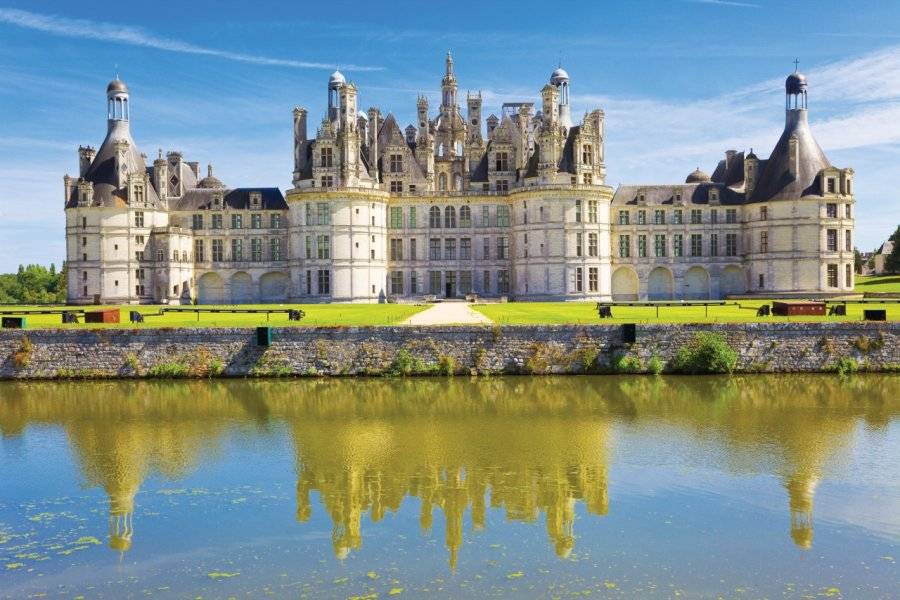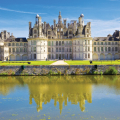DOMAINE NATIONAL DE CHAMBORD
This castle is a jewel of architecture and nature, born from the dream of François I and inspired by Leonardo da Vinci.
Much more than a castle, Chambord is a jewel of architecture and nature, born from the dream of François I and inspired by Leonardo da Vinci. A symbol of perpetual resurrection, it is the largest Renaissance castle still intact. The visit immerses the public in a unique and enchanting atmosphere. Emblem of the French Renaissance throughout the world, Chambord cannot be dissociated from its natural environment, the forest. With its 5,440 hectares and its 32 kilometers of surrounding walls, the national domain of Chambord is the largest enclosed park in Europe. The activities are particularly varied... Using digital tablets using augmented reality (called Histopad, they can be rented at the entrance of the castle), the public rediscovers Chambord and explores the castle as it was in the 16th century. While the virtual world has been put to work for history, guided tours are more relevant than ever and allow curious visitors to discover rooms otherwise inaccessible to the public.
With the construction of the Château de Chambord, François I was not looking for a new permanent residence: he wanted to create a showcase to dazzle the rest of the world, to assert his sovereignty and to inscribe himself in posterity. In 32 years of reign, the king spent only 42 days at Chambord! Most of the time, the castle is empty of furniture and people, except for the workers who work there. Chambord only comes to life when the king arrives, in great pomp, with his court and his furniture. To give the castle the appearance it had during the visits of Francis I, it was necessary to trick the rooms are now furnished with a mixture of period furniture and contemporary reproductions, created in respect of historical knowledge to evoke, as accurately as possible, life during this period. Over the centuries, the castle of Chambord, too far away from the usual places of residence of the sovereigns, was deserted by the central power and finally quite little inhabited. Following the example of François I, the following kings did not live there and did not really undertake any work. In a way, it was the people who appropriated the place, as evidenced by the thousands of graffiti, some of which were painted before the castle was even opened. The walls of Chambord tell a parallel story, over five centuries, engraved in the soft tufa stone.
Although neglected by the sovereigns, the castle of Chambord will never cease to captivate and remains today one of the most beautiful jewels of French heritage. François I knew how to surround himself with the best artists, intellectuals and inventors of his time to create a dazzling, mysterious monument, mixing elements of the Renaissance and the Gothic style while allowing a true modernity to express itself. Chambord is not the result of the work of a single architect but a collective work. The shadow of Leonardo da Vinci looms large over the masterpiece of the castle, its magnificent double staircase. Installed in the center of the keep, the first building erected in 1519, this double spiral staircase has two flights of stairs that intertwine and can be climbed in parallel without ever meeting, and a hollow core pierced with facetious windows.
The gardens. The major axes are extended on both sides of the castle, offering a magnificent perspective. Our gaze is directed, and the castle seems to be enthroned in the middle... Although Chambord has never been a castle of gardens, plants have an important place in the sculptures and interior decorations.
Since 2017, there are also beautiful French gardens. Thanks to a research work, the visitor can now look at the reproduction, to the centimeter, of the pleasure garden as it was in 1734. The restitution was a large-scale project with the planting of 600 trees, 800 shrubs, 200 rosebushes, 15,250 plants delimiting the borders, and 18,874 m² of lawn! Take the time to discover these flowerbeds and admire them from the view of the castle's roofs. However, one must imagine that the pleasure garden did not exist under François I. A very different landscape appeared to him then: the Cosson river crossed the park from east to west and meandered forming a set of swamps that made the place unhealthy.
The park. Classified as a historical monument, like the pleasure garden, it is an integral part of the Chambord experience. Some say that the Chambord castle was first and foremost designed as a hunting lodge! The most sumptuous, luxurious and extravagant hunting lodge there is, but it is true that Francis I never intended to reside at Chambord, and when he was on the estate, the king spent most of his time hunting with his intimates. Of the 5,440 hectares of Chambord park, 800 hectares are open to the public. On a beautiful day, it is a pleasure to explore the largest forest park in Europe on foot, by bicycle, in a horse-drawn carriage or even in a 4x4. Even today, the walks are conducive to meeting a wide variety of animals. Foxes, deer, mouflons, wild boars, and a multitude of bird species will certainly come to greet you. The most: during the bellowing, the stags of the domain offer a bewitching spectacle. Unquestionably, a visit not to be missed.
Did you know? This review was written by our professional authors.
The strengths of this establishment:
Members' reviews on DOMAINE NATIONAL DE CHAMBORD
The ratings and reviews below reflect the subjective opinions of members and not the opinion of The Little Witty.













